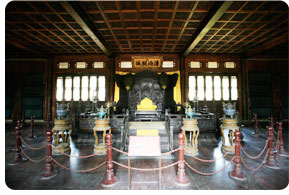 Chengde Mountain Resort (Imperial Summer Villa) Chengde Mountain Resort (Imperial Summer Villa)
避暑山庄
Chengde Mountain Resort is one of China's leading scenic spots and the world's largest imperial garden, which was used to be a summer resort and hunting ground for emperors of the Qing Dynasty (1644-1911). The Mountain Resort, located in Chengde City, Hebei Province, covers an area of 564 square meters, almost half of Chengde's urban area. The mountain resort possesses scenery of both north and south China. Construction began in 1703 under the rule of Emperor Kang Xi and was completed in 1790 under the rule of Emperor Qian Long. In December, 1994 The Chengde Mountain Resort and temples around it was listed in the Chronology of Recognition of World Heritage in China.
This fanciful park covers a huge 590 hectares and is bounded by a splendid 10 km wall. The Rehe, the shortest river in the world, only 14.7 kilometers long, runs through the resort. Emperor Kangxi decreed that there would be 36 'beauty spots' in Jehol (the old name for Chengde); Qianlong decreed 36 more. More than 100 buildings are included and the resort is divided into two sections: palace zone and garden zone. With some imagination you can perhaps detect traces of the original scheme of things, with landscaping borrowed from the southern gardens of Suzhou, Hangzhou and Jiaxing, and from the Mongolian grasslands.
Passing though Lizheng Gate, the main gate, you arrive at the Front Palace (Zhenggong), containing the main throne hall and the refreshingly cool Hall of Simplicity and Sincerity, built of an aromatic hardwood called nanmu, and displaying a carved throne; a gorgeous fragrance emanates from the wood. The emperor's bedrooms are fully furnished. Around to the side is a door without an exterior handle (to ensure privacy and security for the emperior), through which the lucky bed partner for the night was ushered before being stripped and searched by eunuchs. Other halls display exhibitions of ceramics, drum stones and calligraphy.
The double storey Mistry Rain Tower(Yanyu Lou), on the north-western side of the main lake, was an imperial study. Further north is the Wenjin Chamber(Wenjin Ge), built in 1773 to house a copy of the Sikuquanshu, a major anthology of classics, history, philosophy and literature commissioned by Qianlong. The anthology took 10 years to put together. Four copies were made, but three have disappeared; the fourth is in Beijing.
In the east, tall Yongyousi Ta soars above the fragments of its vanished temple. Wander around the pagoda and inspect the temple layout that was levelled by the Japanese.
About 90 percent of the compound is taken up by lakes, hills, mini-forests and plains(where visitors now play football), with the odd vantage-point pavilion. At the northern part of the park the emperors reviewed displays of archery, equestrian skills and fireworks. Horses were also chosen and tested here before hunting sorties.
The Shanzhuang Zoo in the south-east is one of the cleanest and prettiest zoos in China, although it is very small. Decked out with flowers and regular swept, the zoo houses some well-kept animals, including a marvellous Siberian tiger (and its cubs), a great lioness, bears, yaks, ostriches and monkeys.
Rampaging warlords and Japanese had taken their toll on the park, and even the forests have suffered cutbacks. Even so, the park is a great place to stroll in the shade of the trees and slowly take in the scale of the place.
|



